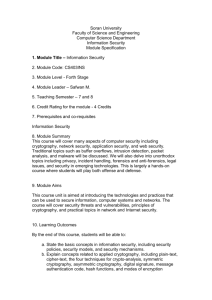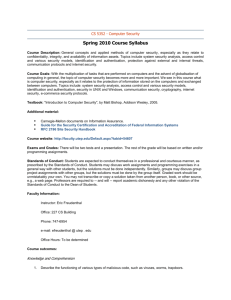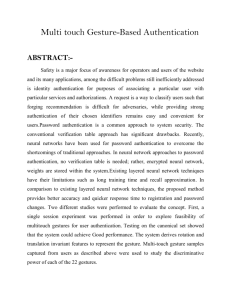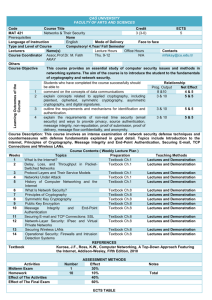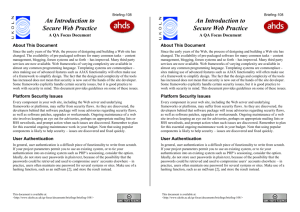security
advertisement
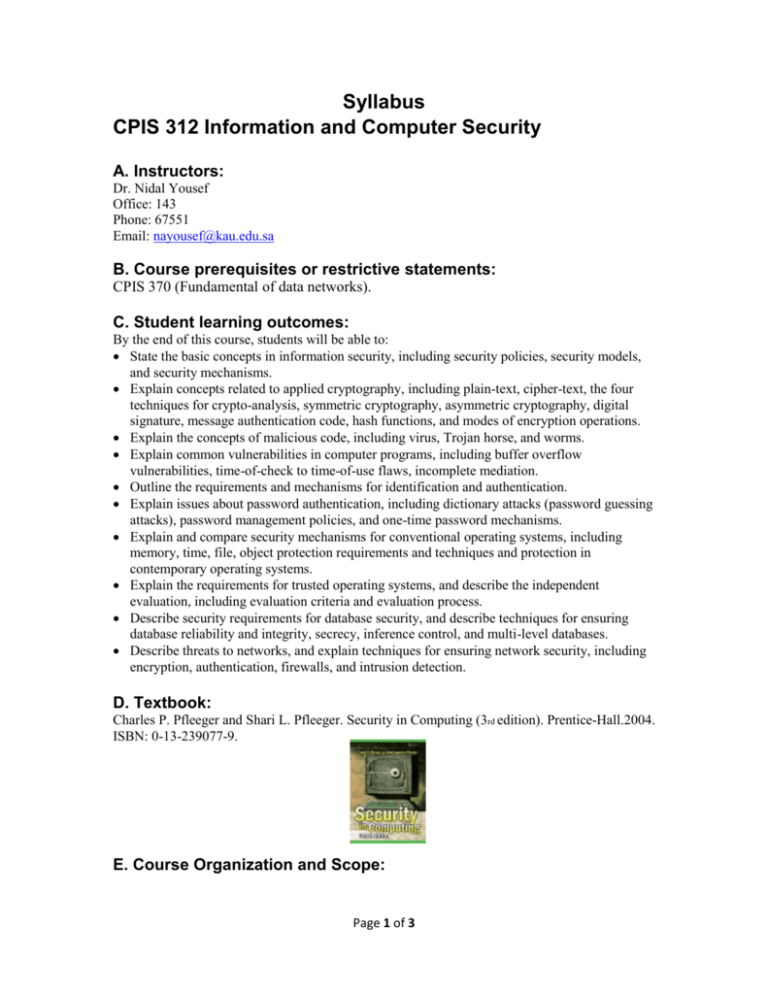
Syllabus CPIS 312 Information and Computer Security A. Instructors: Dr. Nidal Yousef Office: 143 Phone: 67551 Email: nayousef@kau.edu.sa B. Course prerequisites or restrictive statements: CPIS 370 (Fundamental of data networks). C. Student learning outcomes: By the end of this course, students will be able to: State the basic concepts in information security, including security policies, security models, and security mechanisms. Explain concepts related to applied cryptography, including plain-text, cipher-text, the four techniques for crypto-analysis, symmetric cryptography, asymmetric cryptography, digital signature, message authentication code, hash functions, and modes of encryption operations. Explain the concepts of malicious code, including virus, Trojan horse, and worms. Explain common vulnerabilities in computer programs, including buffer overflow vulnerabilities, time-of-check to time-of-use flaws, incomplete mediation. Outline the requirements and mechanisms for identification and authentication. Explain issues about password authentication, including dictionary attacks (password guessing attacks), password management policies, and one-time password mechanisms. Explain and compare security mechanisms for conventional operating systems, including memory, time, file, object protection requirements and techniques and protection in contemporary operating systems. Explain the requirements for trusted operating systems, and describe the independent evaluation, including evaluation criteria and evaluation process. Describe security requirements for database security, and describe techniques for ensuring database reliability and integrity, secrecy, inference control, and multi-level databases. Describe threats to networks, and explain techniques for ensuring network security, including encryption, authentication, firewalls, and intrusion detection. D. Textbook: Charles P. Pfleeger and Shari L. Pfleeger. Security in Computing (3rd edition). Prentice-Hall.2004. ISBN: 0-13-239077-9. E. Course Organization and Scope: Page 1 of 3 (Assume each lecture takes 75 minutes. The following topics need 27 lectures. These will be adjusted based on the actual progress in a semester.) T1. Introduction (2 lectures) Basic concepts: threats, vulnerabilities, controls; risk; confidentiality, integrity, availability; security policies, security mechanisms; assurance; prevention, detection, deterrence T2. Basic cryptography (5 lectures) Basic cryptographic terms Historical background Symmetric crypto primitives Modes of operation Cryptographic hash functions Asymmetric crypto primitives T3. Program security (4 lectures) Flaws Malicious code: viruses, Trojan horses, worms Program flaws: buffer overflows, time-of-check to time-of-use flaws, incomplete mediation Defenses Software development controls Testing techniques T4. Security in conventional operating systems (5 lectures) Memory, time, file, object protection requirements and techniques Protection in contemporary operating systems Identification and authentication Identification goals Authentication requirements Human authentication Machine authentication T5. Trusted operating systems (3 lectures) Assurance; trust Design principles Evaluation criteria Evaluation process T6. Database management systems security (4 lectures) Database integrity Database secrecy Inference control Multilevel databases T7. Network security (4 lectures) Network threats: eavesdropping, spoofing, modification, denial of service attacks Introduction to network security techniques: firewalls, virtual private networks, intrusion detection. F. Schedule of reading assignments: Topic T1: Chapter 1. Page 2 of 3 Topic T2: Chapter 2. Topic T3: Chapter 3. Topic T4: Chapter 4 Topic T5: Chapter 5. Topic T6: Chapter 6. Topic T7: Chapter 7. .H. Grading: Assignments 20% First 15%, Second 15% Final 30%, Lab. 20%. Page 3 of 3

